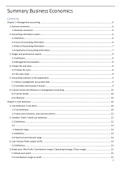Summary
Summary Business economics IBM1 Semester 1
- Course
- Institution
Summary of the Business economics course given by Jan Claes in the 1st semester in the first year of IBM. Summary is based on the powerpoints and containes all things you need to know for the exam. Not all excersices are included.
[Show more]




